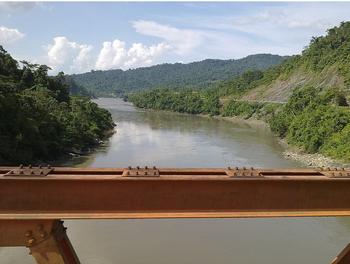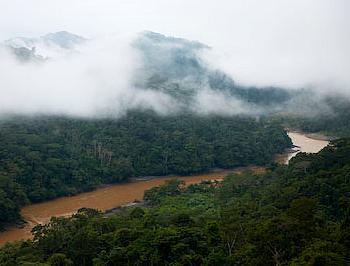Peru Revokes Permit for Giant Dam on Amazon Tributary
LIMA, Peru, June 16, 2011 (ENS) – After years of community opposition, a 2,000 megawatt dam planned for construction on a major Amazonian tributary, has been cancelled, the government of Peru announced Tuesday. The dam was to have been built across the Inambari River in Madre de Dios province.
For the past 36 days, some 2,000 people in the Puno area blocked access roads to the region and held mass protests to convince the government to cancel mining concessions and the dam project.
To appease the strikers, the government established a high-level commission to review the Inambari dam.
After a tense meeting with local communities on June 13, Commission Chair and Vice-Minister of Energy Luis Gonzales Talledo cancelled the project, stating that the Brazilian EGASUR consortium’s rights to develop the project had been revoked.
“Although this resolution does not prevent the construction of all dams in the Inambari Basin, it is very important because it clearly cancels EGASUR’s participation,” said Aldo Santos, from the local nongovernmental organization Rural Educational Services, or SER.
 |
The Inambari River and land that would be flooded if the dam were to be built. (Photo by jhesus1) |
“The resolution states that all future proposed projects must be subjected to prior consultation with local communities according to ILO Convention 169 on Indigenous and Tribal Peoples, which is an important precedent,” said Santos.
Affected communities have long opposed the Inambari Dam, which would have flooded 410 square kilometers of forest, including part of the Bahujan Sonene National Park buffer zone.
The project would have left more than 15,000 people without the agricultural lands that provide their livelihood. Flooding of 120 kilometers of the recently built Inter-Oceanic Highway would have severed access to markets and affected the economic development of the district of San Gaban and the province of Carabaya in Puno State.
“This is a great triumph for the communities and the Peasant Patrols, and we will continue to defend our lands and our culture,” said Olga Cutipa, president of the Front to Defend the Inambari-San Gaban.
“Even though the project is cancelled we know that we have won the battle but not the war. We know there are too many interests behind construction of Inambari, especially the interests of the Brazilians and their energy thirst,” she said.
The cancellation of the project is a blow to the Brazilian government, which signed an Energy Agreement with Peru last year committing to purchase electricity from six dams in the Peruvian Amazon.
 |
The Inambari River flows through pristine Amazon rainforest. (Photo by SPDA Actualidad Ambiental) |
The US$4.9 billion Inambari Dam was expected to be financed by the Brazilian National Development Bank and to be built by Brazilian construction companies. The Brazil Energy Expansion Plan for 2011-2020 includes a total of 7,000 megawatts of imported hydropower from the Peruvian Amazon.
The Inambari Dam, which until now was at the most advanced stage of planning, was expected to produce 2,000 megawatts, equal to about a quarter of the country’s current installed capacity.
The second proposed dam under the Brazil-Peru Agreement, the Pakitzapango Dam, was stopped in 2010 by an administrative legal action by the Central Ashaninka del Rio Ene, an indigenous organization.
Earlier this month, Peruvian NGOs demanded a public debate to review the Peru-Brazil Energy Agreement when the new Congress meets in July.
In their statement, the NGOs said “With the Agreement, we would be choosing to give away our energy to external markets at the expense of serious environmental and social impacts for the country. The approval of the agreement adversely compromises any serious effort to planning for long-term sustainable development of the country.”
Monti Aguirre, Latin America Program coordinator for International Rivers, an NGO based in California, said, “This is a great day for the Peruvian Amazon and the communities who have fought for so long to protect their rights and their environment.”
“Both Brazil and Peru are rich in alternative energy sources,” said Aguirre. “If Brazil invested in energy efficiency, it could avoid the need for any dams to be built in the Amazon Basin and save billions of dollars in the process. The Amazon is simply too precious a resource to squander.”
Although it has become clear that EGASUR will not build Inambari, Puno’s population is still protesting the issuance of mining and oil concessions in the province.
Copyright Environment News Service,ENS, 2011. All rights reserved.
